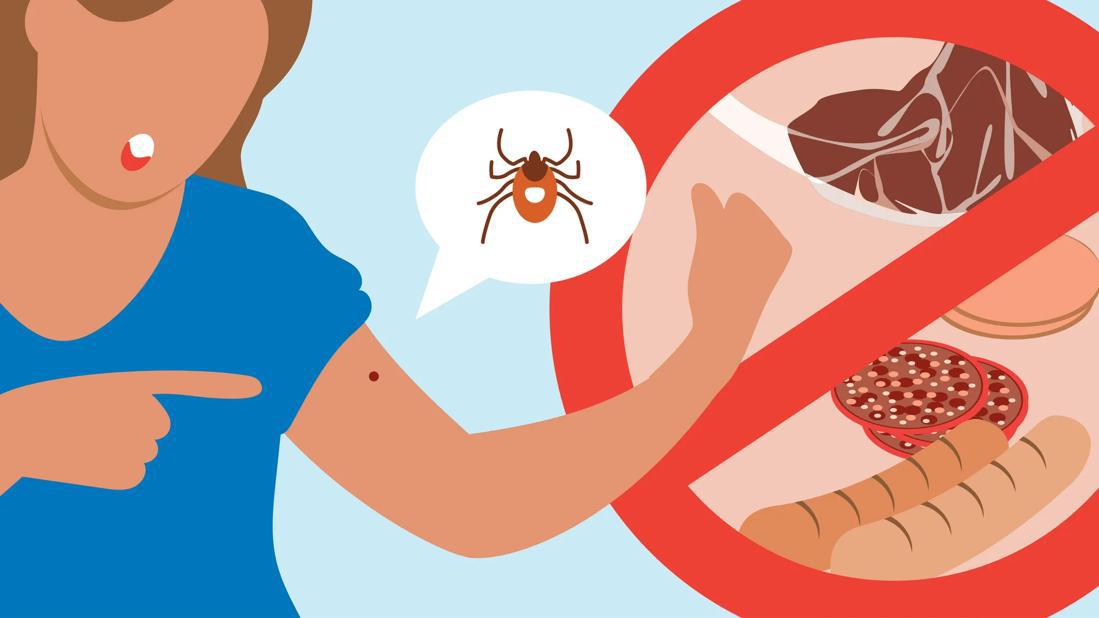How a Tick Bite Can Make You Allergic to Meat
Alpha-gal syndrome has become more common and is a leading cause of anaphylaxis

Bad news, burger fans: A tick bite can permanently remove red meat from your menu.
A meat allergy known as alpha-gal syndrome (AGS) is typically triggered by a tick bite. Case counts are growing, too. There were only 24 reported cases in the United States in 2009. Between 2010 and 2022, researchers documented more than 110,000.
Today, AGS is a leading cause of anaphylaxis, or severe allergic reaction, in certain areas of the country.
“Tick bites are an unusual way to become allergic to a substance,” says allergist Frank Eidelman, MD. “But alpha-gal syndrome is something to be aware of — especially if you’re having unexplained allergic reactions.”
So, what do we know about this emerging allergy that threatens to cool the coals on our favorite backyard grill options? And what can you do to avoid it? Dr. Eidelman has some food for thought.
What tick causes red meat allergy?
One little bugger — the lone star tick — appears to be the main source of AGS in the United States. The tick is very aggressive and most active (and biting) from early spring through late fall.
The lone star tick gets its name from the appearance of the adult female, which has a single white dot — or “lone star” — on its back. The tick has long called southeastern states home, but its range has now expanded into the Midwest and Northeast.
But other tick species haven’t been ruled out as potential sources of AGS. The reason? “There are other parts of the world where this phenomenon has been identified, and the lone star tick is not there,” notes Dr. Eidelman.
How a tick bite triggers alpha-gal syndrome
Ticks feed on blood after they bite, but those parasites don’t just take. They also might leave something behind from their saliva — specifically, a sugar molecule called alpha-gal (α-Gal).
When alpha-gal from a tick enters your bloodstream, your body can suddenly build a sensitivity to red meat (which also contains alpha-gal). Eventually, your immune system may start viewing red meat as a danger when it hits your belly.
What happens next? Well, your immune system goes into attack mode and releases antibodies to combat the perceived threat. This kicks off an allergic reaction.
Like most food allergies, reactions can range from mild to life-threatening and include:
- Skin rashes or hives, which are present in the vast majority of AGS reactions
- Gastrointestinal issues, such as heartburn, severe stomach pain or diarrhea
- Difficulty breathing
- Swelling of your lips, throat or tongue
But what’s unusual about AGS reactions is how long it takes for symptoms to appear. Most AGS reactions occur three to six hours after eating. (For comparison, most food allergy reactions take place within minutes.)
“That delay can make it more challenging to make a direct association with what was eaten,” says Dr. Eidelman.
Most tick-driven cases of AGS occur in people who previously had no issues eating red meat.
When to see a doctor for AGS
Talk to a healthcare provider if you show signs of AGS after eating red meat. This includes beef, pork and lamb, as well as meat from other furry, warm-blooded mammals like deer and rabbits. “All of these can cause a reaction,” says Dr. Eidelman.
Other foods connected to AGS reactions include:
- Dairy products
- Beef tallow and lard (rendered cow and pig fat)
- Gelatin, which is made from boiling animal bones, skin and tissue
AGS isn’t connected to poultry meat (like chicken or turkey) or fish and seafood.
Confirmation of the allergy typically comes through a blood test that looks for antibodies to alpha-galactose. A skin test may also be done.
Some people with AGS will be prescribed an epinephrine auto-injector — more commonly known by the name EpiPen® — for potential use in case of an anaphylactic reaction, says Dr. Eidelman.
Over-the-counter antihistamines can be used to help ease symptoms for less severe reactions.
There isn’t a current cure for AGS.
How to prevent AGS from tick bites
Given that tick bites are the main cause of AGS, taking proper precautions while outdoors is your best defense against the syndrome, says Dr. Eidelman. He recommends:
- Covering up: Wear clothing that completely covers your skin in areas with tick activity. That means long-sleeve shirts, pants and high socks. Tucking your pant legs into your socks can provide added protection.
- Using bug sprays: Applying bug spray to your clothes and skin can help ward off creepy crawlies. DEET-based repellants are safe to use.
Make sure to check your clothing and skin for ticks before coming back inside, too. Remove any attached ticks with tweezers ASAP. (Here’s how to safely remove the burrowed-in bugger from your skin.)